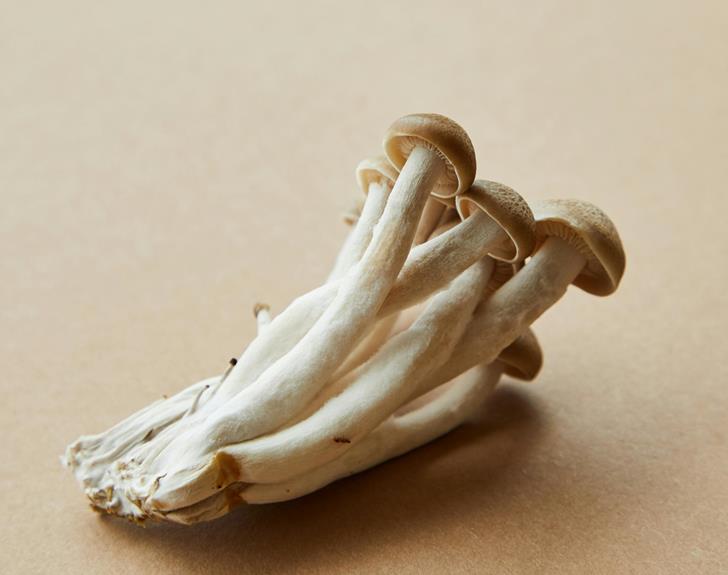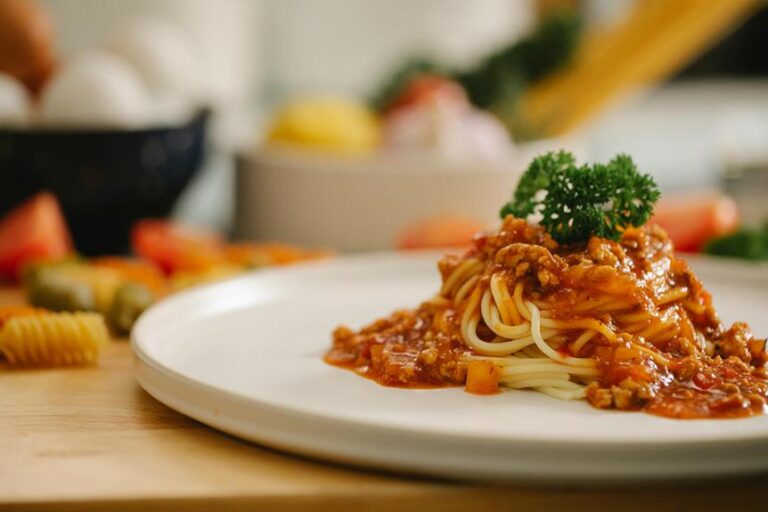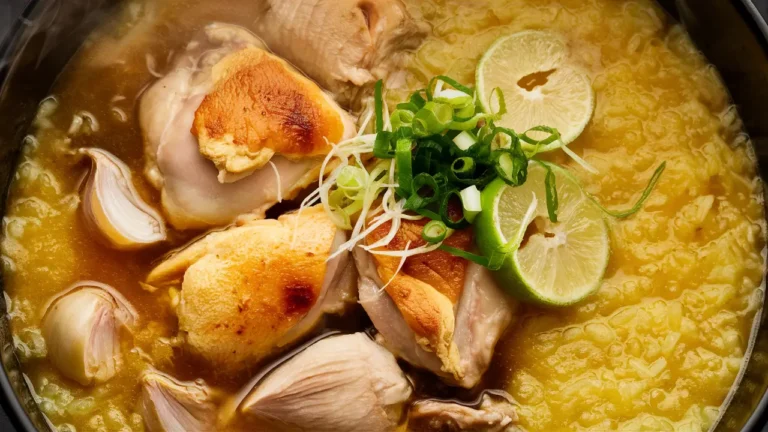Sizzling Sisig: How This Filipino Delicacy Became a Global Sensation

Sizzling Sisig, hailing from Pampanga, Philippines, transforms humble pig parts like the face and ears into a culinary masterpiece. You'll relish how its crispy and tender textures, seasoned with onions, chili peppers, and calamansi juice, create a symphony of flavors bursting on your taste buds. Traditionally served on a sizzling platter and often topped with a sunny-side-up egg, Sisig reflects Filipino ingenuity and cultural pride. Over time, innovative variations like chicken, tofu, and fish sisig have emerged, making this once-local delicacy a global sensation. Discover how this dish's journey from resourcefulness to international fame captures food lovers' hearts everywhere.
Key Takeaways
- Sisig originated in Pampanga, Philippines, showcasing Filipino culinary ingenuity by utilizing every part of the pig.
- The dish features a distinct mix of crispy and tender textures from pig face, ears, and liver.
- Essential flavorings like onions, chili peppers, and calamansi juice create a unique and balanced taste profile.
- Sisig's versatility with alternative ingredients like chicken, fish, and tofu appeals to global palates.
- Presentation with sizzling plates and pairing with beverages enhances the dining experience, making it more appealing internationally.
Origins of Sisig
The origins of Sisig trace back to the resourceful chefs of Pampanga, Philippines, who transformed pig's head, ears, and cheeks into a culinary masterpiece. These inventive cooks utilized every part of the pig, ensuring nothing went to waste. They grilled the meat over charcoal, then chopped it finely and seasoned it with calamansi and chili peppers, creating a dish with a remarkable balance of tangy, spicy, and delicious flavors.
Sisig's culinary evolution is a tribute to Filipino ingenuity. What started as a humble dish has now become a symbol of cultural pride. In Pampanga, Sisig was more than just food—it was a reflection of the community's resilience and creativity. Over time, this dish gained popularity throughout the Philippines, celebrated for its unique blend of flavors and textures, from crispy to succulent.
As Sisig's reputation grew, its cultural significance only deepened. It became a staple at gatherings and celebrations, a dish that brought people together. Its journey from a local delicacy to a global sensation showcases its adaptability, allowing it to be reinvented with different meats, seafood, and even vegetarian options, catering to diverse palates worldwide.
Traditional Ingredients
When you think of traditional sisig, imagine the crispy and tender textures of pig face, ears, and liver, meticulously boiled, grilled, and chopped.
These key pork cuts are paired with essential flavorings like onions, chili peppers, and calamansi juice to create a symphony of taste.
The preparation techniques, honed over generations, guarantee each bite is a perfect balance of savory, tangy, and spicy.
Key Pork Cuts
Imagine biting into a dish where every bite offers a medley of textures and flavors, thanks to key pork cuts like pig face and ears that give sisig its authentic taste. These unique pork selections are integral to the dish, contributing to its rich and multifaceted flavor profiles. The cooking methods involved—boiling, grilling, and chopping—transform these cuts into tender, crispy, and chewy pieces that provide a delightful texture variation with each bite.
In traditional sisig, pork belly and maskara (face) are commonly used, adding a fatty richness that elevates the dish. The combination of these different pork cuts adds depth and complexity, creating a symphony of flavors that dance on your palate. Each bite is a harmonious blend of savory, smoky, and slightly charred notes, making sisig a truly unforgettable experience.
While pork is the star of traditional sisig, don't hesitate to experiment! Alternative ingredients like chicken, fish, or even tofu can offer new twists, maintaining the dish's essence while catering to different dietary preferences. Whether you stick to the classic pork or venture into other proteins, sisig's appeal lies in its ability to adapt and still deliver that iconic, mouthwatering taste.
Essential Flavorings
Plunge into the heart of sisig's essence with a blend of traditional ingredients that include pork face and ears, onions, chili peppers, and calamansi juice, each contributing to the dish's unforgettable taste. These essential flavorings work in harmony, creating a symphony of delightful, tangy, and spicy notes that dance on your palate.
| Ingredient | Role in Flavor | Texture Contribution |
|---|---|---|
| Pork Face & Ears | Richness in taste | Tender and chewy |
| Onions | Sweet & pungent | Crunchy |
| Chili Peppers | Spicy heat | Crisp |
| Calamansi Juice | Tangy brightness | Juicy |
The secret to sisig's distinctive taste lies in these unique combinations. Pork face and ears provide a rich, meaty base, while onions add a sweet pungency that balances the heat from the chili peppers. Calamansi juice, with its sharp tang, cuts through the richness, brightening each bite.
The beauty of sisig is in its taste experimentation. Some may add chicken liver or liver spread for a deeper flavor, while others might stir in mayonnaise for a creamy twist. Don't forget the chicharon for that irresistible crunch. These seasoning secrets are what make sisig a beloved dish, allowing you to explore and relish every delicious nuance.
Preparation Techniques
Mastering sisig's unforgettable flavor starts with perfecting the preparation techniques that transform traditional ingredients into a culinary masterpiece.
Begin with the essentials: pig face, ears, and cheeks. First, boil these parts until tender, then move on to grilling. This dual cooking method is one of the grilling secrets that give sisig its signature texture—crispy on the outside, yet tender inside.
Next, incorporate chicken liver for a rich, complex flavor. Chop the boiled and grilled meats finely, ensuring every bite is a harmonious blend of textures.
Traditional sisig isn't complete without key ingredients like onions, chili peppers, and calamansi juice. These not only enhance the dish's flavor but also contribute to its vibrant Sisig presentation.
To elevate the dish further, use flavorful marinades to soak the meat before grilling. It infuses every bite with depth and character. Mayonnaise can be added for creaminess, an innovation that has gained popularity in modern sisig variations.
Finally, sprinkle chicharon on top for a delightful crunch, adding a final layer to the dish's multifaceted texture.
Embrace these techniques, and you'll be on your way to creating an authentic and irresistible sisig that honors its traditional roots while welcoming Sisig innovations.
Step-by-Step Preparation
Starting with boiling the pork belly and maskara for an hour, you'll tenderize the meat before moving on to the grilling stage. This initial step by step tip ensures that the pork becomes tender and easy to chew, setting the foundation for a perfect sisig.
The next cooking technique involves grilling the boiled meat to achieve a crispy texture and smoky flavor, which are essential characteristics of this beloved Filipino dish.
Once the meat is grilled to perfection, the next step is to sauté onions until they're translucent, adding a sweet and delectable depth to the sisig. Don't forget to cook chicken livers separately; they bring an additional layer of richness to the dish.
Afterward, chop the grilled meat into small pieces and mix it with the sautéed onions and cooked chicken livers.
For that signature sisig flavor, combine the chopped meat with chicharon, seasonings, and a dollop of mayonnaise, giving it a creamy, delectable finish.
Customizing Your Sisig
Now that you've mastered the basics of preparing traditional sisig, it's time to explore exciting ways to customize this beloved dish to suit your personal tastes.
One of the simplest ways to start is by adjusting the level of spiciness. Love a fiery kick? Add more chili peppers. Prefer it milder? Use fewer. The versatility of sisig allows you to experiment with a range of ingredients, creating unique combinations that delight the palate.
For an extra crunch, consider topping your sisig with crispy chicharon or crushed pork cracklings. These flavorful toppings add both texture and depth.
If you're feeling adventurous, try incorporating different proteins like tofu, seafood, or even other meats. Each variation brings its own distinct taste and character to the dish.
Tailoring the seasoning is another fantastic way to make sisig your own. Adjust the amount of calamansi juice or soy sauce to match your flavor preferences.
For those who crave creamier sisig, adding more mayonnaise or incorporating ingredients like cheese or sour cream can elevate the dish to new creamy heights.
Serving Suggestions
Serving sisig on sizzling metal plates not only keeps the dish hot and inviting but also enhances the dining experience with its tantalizing presentation. Preheat the plates before serving to make sure your sisig stays hot and crispy. This method showcases traditional plating techniques, creating a sensory delight that's hard to resist. Don't forget to top your sisig with a sunny-side-up egg and provide cut calamansi on the side for diners to adjust the flavor to their liking.
Pairing sisig with the right beverages can elevate the meal's enjoyment. A cold beer or a revitalizing calamansi juice works wonders when balancing the dish's rich flavors. These beverage pairings are not just about taste—they carry cultural significance, reflecting Filipino dining customs.
Here's a quick guide to enhance your sisig experience:
| Aspect | Suggestion |
|---|---|
| Plating | Use sizzling metal plates |
| Toppings | Sunny-side-up eggs |
| Adjustments | Provide cut calamansi |
| Flavor Pairings | Cold beer, calamansi juice |
| Cultural Touch | Reflects Filipino dining customs |
Storage Tips
When it comes to storing your leftover sisig, you'll want to keep it in an airtight container to preserve its tantalizing flavors.
For the best results, refrigerate it for up to 3 days or freeze it for up to 2 months.
When you're ready to enjoy it again, thaw it in the fridge overnight and reheat it in a wide pan or microwave until it reaches a sizzling 165°F.
Proper Leftover Storage
To maintain your leftover sisig as tasty as when it was first served, always store it in a container with a tight lid to preserve its freshness. Proper leftover storage is key to flavor preservation, securing each bite remains as mouthwatering as the first.
When it comes to storing your sisig, the refrigerator is your ally for short-term needs. You can keep your leftover sisig in the fridge for up to 3 days. For longer storage, the freezer is ideal, safeguarding your sisig for up to 2 months. Remember to thaw frozen sisig in the refrigerator overnight before reheating.
Here's a helpful table to guide you:
| Storage Method | Duration | Tips |
|---|---|---|
| Refrigerator | Up to 3 days | Use an airtight container. |
| Freezer | Up to 2 months | Freeze in portion sizes for ease. |
| Thawing | Overnight | Thaw in the fridge for best results. |
Using these storage tips guarantees that your sisig retains its vibrant flavors and satisfying textures. You'll want to reheat it properly to enjoy its full essence, which we'll cover next. By following these guidelines, you keep every serving of sisig tasting just as spectacular as the first.
Effective Reheating Methods
One foolproof way to enjoy your leftover sisig at its peak is by reheating it properly to retain its delightful flavors and textures. Proper reheating not only ensures food safety but also offers opportunities for flavor enhancement and creative presentation.
Here are some reheating hacks and storage tips to make the most out of your leftover sisig:
- Storage: Keep your leftover sisig in a container with a tight lid in the refrigerator for up to 3 days or freeze it for up to 2 months.
- Thawing: Thaw frozen sisig in the refrigerator overnight for even reheating.
- Reheating: For best results, reheat sisig in a wide pan until it reaches an internal temperature of 165°F. Alternatively, use a microwave but be sure to stir occasionally.
- Presentation tips: Preheat a sizzling metal plate before serving the reheated sisig to enhance its visual appeal and flavor.
- Ingredient substitution: Consider adding fresh calamansi juice or a sprinkle of chopped chili to give your reheated sisig a zesty kick.
Popular Variations
Sisig's versatility shines through in its popular variations, each bringing its own unique twist to this beloved Filipino dish. If you're looking for vegan options, Sizzling Tofu Sisig is a must-try. This meat-free alternative uses tofu to replicate the classic sisig texture while delivering those flavorful twists you crave.
For those seeking regional variations, Bangus Sisig is a standout, featuring milkfish as the main ingredient. This adaptation adds a delightful, fishy flair that remains true to sisig's essence yet offers something delightfully different.
Regional and fusion cuisine enthusiasts won't want to miss Chicken Sisig, which swaps traditional pork for chicken thighs. This version isn't only lighter but also packs a punch with its own unique blend of spices. Meanwhile, Crispy Sisig takes the dish to new textural heights, offering a crunch that contrasts beautifully with the tender meat.
And if you're feeling adventurous, try Lechon Sisig or Squid Sisig to experience a fusion of flavors and ingredients that push the boundaries of traditional sisig.
In every variation, you'll find a celebration of creativity and culinary craftsmanship, proving that sisig's global appeal is well-deserved.
Health and Nutrition
When it comes to sisig, you're looking at a dish that's both a protein powerhouse and a calorie bomb, with each serving packing around 1261 calories and 48 grams of protein.
The high fat content and significant cholesterol levels might make you pause, but there are ways to enjoy sisig more healthily. By swapping out some ingredients, you can still relish its rich flavors without compromising your nutritional goals.
Nutritional Value Breakdown
You might be surprised to learn that sisig, while delicious, packs a substantial caloric punch with its 1261 calories per serving. This Filipino delicacy, known for its rich flavors and delectable goodness, isn't just a treat for your taste buds but also quite the meal in terms of nutritional value.
While there are undeniable nutritional benefits, there are also dietary considerations to ponder.
Sisig is a powerhouse when it comes to being a protein source, offering a significant 48 grams of protein per serving. However, the high caloric content can be a concern for those monitoring their calorie intake. Additionally, the dish is high in fat and cholesterol, which might present challenges for those with specific dietary restrictions.
Here's a quick nutritional breakdown per serving of sisig:
- Calories: 1261
- Protein: 48 grams
- Carbohydrates: 2 grams
- Fat: 115 grams
- Cholesterol: 303 milligrams
Understanding these figures can help you make informed choices about when and how often to enjoy this delightful dish.
While sisig is undeniably a protein-rich meal, balancing it with other nutritious foods can help savor a well-rounded diet.
Healthier Ingredient Alternatives
Exploring healthier ingredient alternatives can transform traditional sisig into a nutritious yet equally flavorful dish. Instead of using pork belly, consider opting for leaner cuts like pork shoulder. This simple swap reduces the fat content without compromising on taste.
Alternatively, chicken thighs are a fantastic lower-fat option that still brings a succulent texture to your sisig.
For those seeking plant-based solutions, meat alternatives like tofu or fish can be game-changers. Tofu sisig isn't only lower in cholesterol and saturated fats but also absorbs flavors beautifully, giving you that umami punch you crave.
Fish sisig, on the other hand, offers a lighter, protein-packed twist with added omega-3 fatty acids, which are excellent for heart health.
Incorporating more vegetables like bell peppers and mushrooms not only enhances the dish's texture but also boosts its fiber and nutrient content. These vibrant additions make every bite more colorful and wholesome.
Additionally, consider reducing or omitting mayonnaise to lower the overall calorie and fat content. Believe it or not, the natural zest of lime and the kick of chili can keep your sisig just as creamy and tantalizing.
Cooking Video Tutorial
For an authentic guide to mastering sisig, watch Vanjo Merano's step-by-step cooking video on PanlasangPinoy.com. This video is a fantastic resource for those interested in virtual cooking classes and interactive learning. Vanjo Merano, the renowned creator of PanlasangPinoy.com, provides expert guidance and practical insights into the culinary arts through his detailed online tutorials.
In this video, you'll learn essential cooking techniques and tips to prepare authentic sisig. Following along visually helps you understand the process from start to finish, ensuring you can replicate this Filipino delicacy in your own kitchen.
Here are some highlights you can expect from the tutorial:
- Ingredient preparation: Learn how to properly prepare and marinate the pork, ensuring maximum enjoyment.
- Cooking techniques: Discover the best methods for grilling, chopping, and sautéing the pork to achieve the perfect texture.
- Flavor balancing: Understand how to balance the tangy, tasty, and spicy elements that make sisig so unique.
- Presentation tips: Get creative ideas on how to serve sisig in an appetizing and authentic way.
- Pro tips: Gain insider tips from Vanjo to elevate your sisig-making skills.
Dive into this video tutorial and enhance your culinary repertoire with the art of making sisig!
Reader Engagement
Joining the Panlasang Pinoy community offers a fantastic opportunity to enhance your culinary skills and connect with fellow food enthusiasts. By engaging with the community, you'll immerse yourself in the rich cultural significance of Filipino cuisine and explore its global influences.
Whether you're a seasoned cook or a curious novice, the platform encourages you to participate by leaving comments or questions about the sisig recipe, fostering a lively culinary conversation.
Don't forget to rate the recipe and share your feedback. Your insights contribute to the evolving story of sisig, a dish that beautifully showcases culinary fusion and its growing international appeal.
When you try your hand at making sisig, snap a photo and share it on Instagram, tagging @PanlasangPinoy. This not only celebrates your creation but also links you with a global network of sisig enthusiasts.
For those visual learners, Vanjo Merano's video tutorial offers step-by-step instructions, making the cooking process accessible and enjoyable.
Feel adventurous? Explore different sisig variations on Panlasang Pinoy, from lechon to squid sisig. Each adaptation highlights the dish's versatility and its ability to blend global influences with traditional flavors, creating a truly unique culinary experience.
Frequently Asked Questions
What Are the Best Beverages to Pair With Sizzling Sisig?
You'll love pairing sizzling sisig with cocktails like a calamansi mojito, or exploring wine pairings with a bold red. For healthy options, try iced tea or coconut water, respecting cultural preferences and enhancing flavor.
How Did Sizzling Sisig Gain International Popularity?
You'll find that sizzling sisig's international popularity stems from culinary fusion and cultural representation. Filipino diaspora communities and social media have spotlighted its unique flavors, making it a global sensation featured in diverse culinary events and menus.
Are There Any Unique Regional Twists on Sizzling Sisig in the Philippines?
You'll find unique regional twists on sizzling sisig in the Philippines, showcasing regional variations and cultural significance. Different ingredients and cooking techniques, like adding pineapple or using a sizzling plate, highlight the diversity of this beloved dish.
What Is the History Behind the Name "Sisig"?
The name 'sisig' originates from the Kapampangan word 'sisigan,' meaning 'to snack on something sour.' Its evolution began in Pampanga, transforming from a simple sour snack into the globally beloved sizzling dish you enjoy today.
Can Sizzling Sisig Be Made Vegan or Vegetarian?
Absolutely, you can make sizzling sisig vegan or vegetarian! Use vegan alternatives like tofu or mushrooms and flavorful substitutes such as seitan or tempeh. Add veggies and experiment with spices to create a delicious, meat-free version.
Conclusion
You've journeyed through the rich history and vibrant flavors of sizzling sisig.
Now, it's your turn to bring this Filipino delicacy to life in your own kitchen.
With its endless customization options and irresistible taste, sisig is more than a dish—it's an experience.
Whether you stick to the traditional recipe or add your own twist, you're sure to create something memorable.
So, grab your skillet and get cooking; the world of sisig awaits you!






